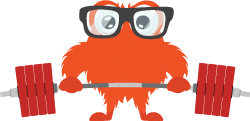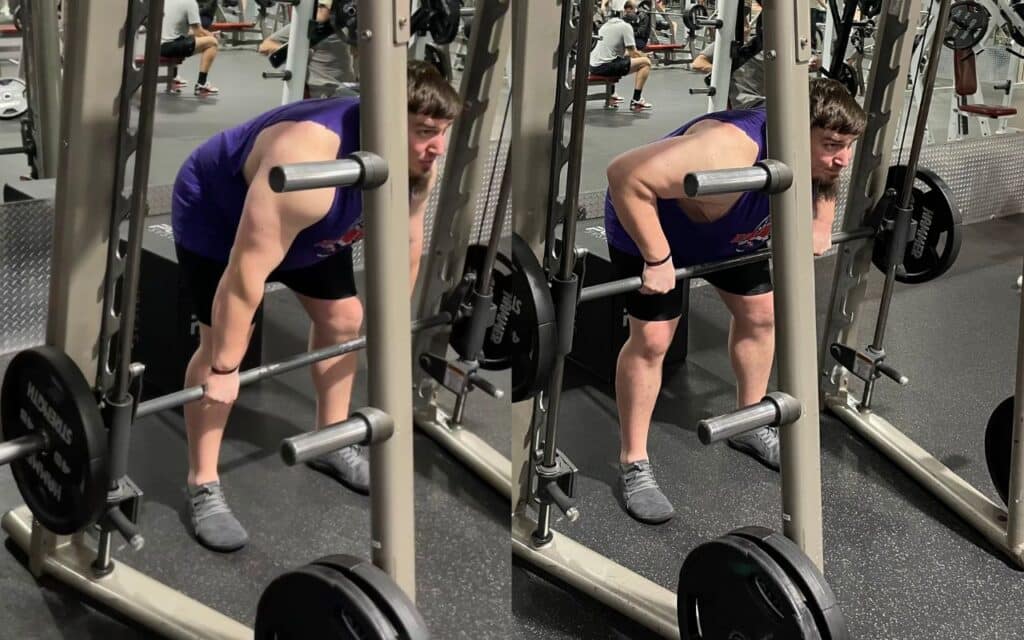
The Smith machine row is an excellent variation to use in place of the barbell row because the Smith machine provides additional stability that will allow you to lift heavier.
This helps strengthen the back muscles, specifically the latissimus dorsi (lats), rhomboids, and trapezius muscles (traps).
I recommend the Smith machine row to all lifters. However, it can be especially beneficial for beginners because it is easier to maintain proper technique than rows with a barbell or dumbbell.
Check out other back exercises using a Smith machine to build a complete workout.
How To Do The Smith Machine Row
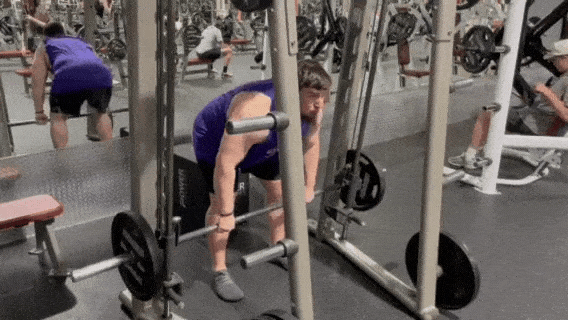
- Set the Smith machine bar below hip height and load the desired weight. Start with a weight that you could comfortably row on a barbell.
- Stand facing the bar with feet shoulder-width apart.
- Grab the bar with an overhand grip, hands slightly wider than shoulder-width apart.
- Bend at the waist by pushing your hips back, like a barbell Romanian deadlift (RDL), keeping your back straight and core engaged.
- Pull the bar towards the lower chest by driving elbows back, squeezing shoulder blades together.
- Lower the bar back down with control.
Pro tip: Keep your chest parallel to the ground and slowly lower the bar back to the starting position. Spending more time under tension will lead to greater back hypertrophy.
Here’s the weight of the Smith machine bar, so you can calculate the weight of your lifts.
Common Mistakes Doing Smith Machine Rows
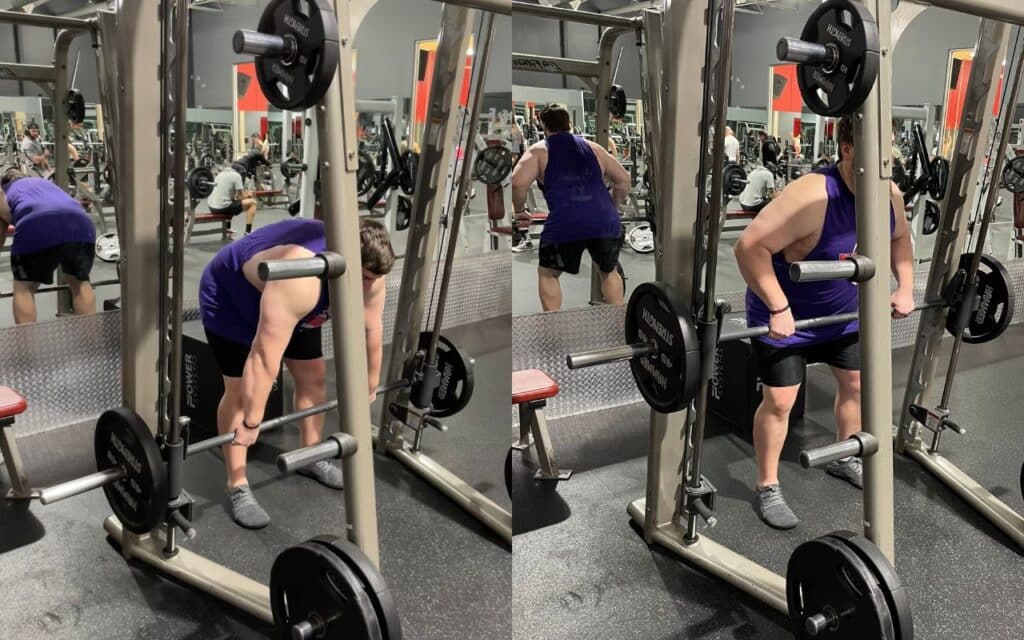
Standing Too Upright
While performing the Smith machine bent-over row, the chest should stay close to parallel to the ground. This allows each rep to work more of the back's musculature.
When the torso is upright, the range of motion is greatly reduced. This means the lats can’t stretch as much at the bottom of the movement, leading to less overall muscular damage.
Using Too Much Momentum
The goal of this movement is to train the back. A common mistake is to load up too much weight and require the use of other muscles to complete a rep.
You’ll often see people lower the bar too quickly, using momentum and their posterior chain to power the weight up out of the bottom portion of the lift. Performing a rep this way puts you at greater risk of creating lower back pain and other back issues.
Check out how the bent-over row compares to the upright row in the full post. I also shared more upright row alternatives to consider.
How To Add Smith Machine Rows To Your Workout
Just as with barbell rows with a standard barbell, Smith machine rows can be programmed in various ways. The choice depends greatly on your performance goals.
Hypertrophy
- If your current training aims to achieve muscle size or hypertrophy, you should perform high reps per set.
- Use a weight that you could do for 8-12 reps per set, then perform 3-5 sets.
- Perform a vertical pull, such as pull-ups or lat pull-downs, before or after Smith machine rows.
Strength
- If you focus on improving strength, you should use heavy weights, and the reps should decrease.
- Use a weight that you could do for 4-6 reps per set, and perform 3-5 sets.
- Perform a vertical pull for the same number of sets and reps, before or after the Smith machine row.
You can also add other back exercises with a Smith machine such as the inverted row, single arm row, shrug, RDL, deadlift, and sumo deadlift.
Muscles Worked During The Smith Machine Row
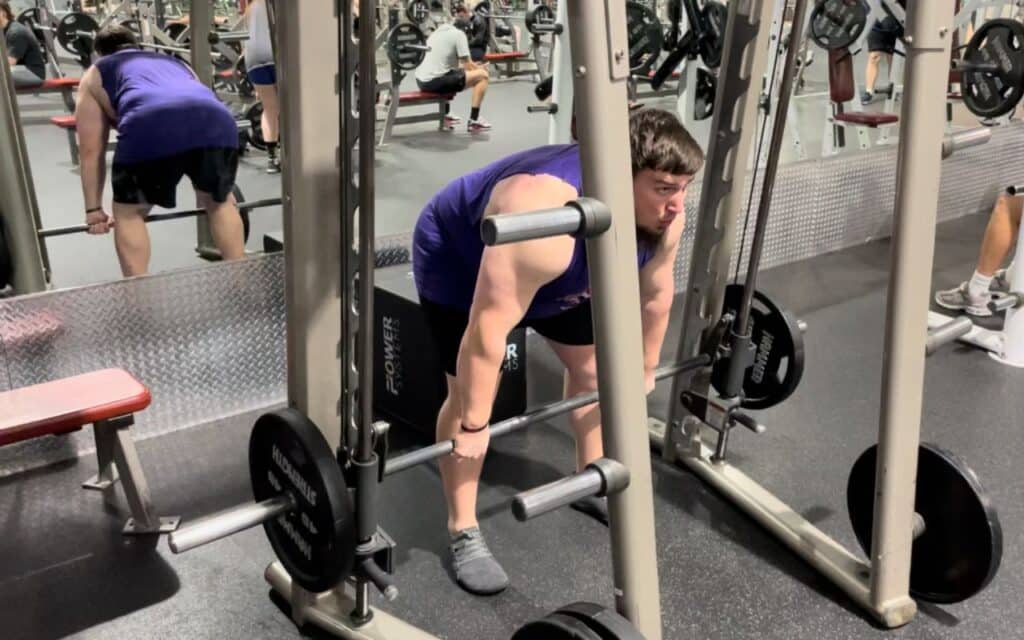
The Smith Machine Row is a great compound exercise for working the back muscles. While the back muscles are the primary muscles trained, several secondary muscle groups are involved to help maintain proper positioning throughout the movement.
The primary muscles worked in the Smith machine row include the following:
- Latissimus Dorsi (Lats): The lats are the primary muscles worked in the Smith machine row. As you pull the bar towards your lower chest, the lats contract to bring your elbows back and shoulder blades together.
- Rhomboids: The rhomboids are located in the upper back and retract the scapulae (shoulder blades). During the row, the rhomboids contract to squeeze the shoulder blades together, stabilizing the shoulder girdle.
- Trapezius (Traps): The traps are also involved in the row. They help to stabilize and retract the shoulder blades during the pulling motion.
The secondary muscles worked in the Smith machine row include the following:
- Biceps Brachii: The biceps act as secondary movers in the row, assisting in the pulling motion, especially during the initial phase of the lift when the elbows are bending.
- Forearms: The muscles of the forearms are engaged to grip the bar and maintain control throughout the movement.
- Core Muscles: The core muscles, including the rectus abdominis, obliques, and transverse abdominis, are engaged to stabilize the spine and prevent excessive arching or rounding of the back during the row.
- Quads, hamstrings, and glutes: Each muscle group isometrically contracts to help maintain the bent-over position with the hips back.
Alternatives To The Smith Machine Row
When choosing alternatives to the Smith machine row, the movements must achieve the same primary goal. Any substitution should also be a horizontal pulling variation and should primarily train the lats, rhomboids, and traps.
Barbell Bent Over Row
The barbell bent-over row is the most obvious choice as a substitution for the Smith machine row. It emphasizes the exact same primary muscle groups as the Smith machine row.
An additional benefit is that free weights require more stability from the abs to maintain proper posture. It will also have a greater effect on grip strength. To perform:
- Stand with your feet shoulder-width apart, holding the barbell with an overhand grip (it can also be performed underhanded), hands slightly wider than shoulder-width apart.
- Bend your knees slightly and hinge at your hips to lean forward, keeping a neutral spine position and chest up. Your torso should be parallel to the ground.
- Let the barbell hang at arm's length towards the floor, with your arms fully extended.
- Pull the barbell towards your lower chest by driving your elbows back, keeping them close to your body.
- Squeeze your shoulder blades together at the top of the movement to engage your back muscles.
- Keeping constant tension, lower the barbell back down with control, fully extending your arms.
T-Bar Row
The t-bar row is a great addition to an upper-body training session. It can overload the same muscle groups involved in the Smith machine row.
However, it should be noted that the same mistakes seen in the Smith machine row are also seen during the t-bar row and should be avoided. To perform:
- Place one end of a barbell into a landmine attachment or secure it in a corner to keep it stable.
- Load weight plates onto the other end of the barbell.
- Straddle the barbell with your feet shoulder-width apart, knees slightly bent.
- Bend at the hips and knees, keeping your back straight and chest up. Your torso should be parallel to the ground.
- Grab the handles with a neutral grip (you’ll likely use a v-grip handle to perform the movement).
- Pull the barbell towards your lower chest by driving your elbows back, keeping them close to your body.
- Squeeze your shoulder blades together at the top of the movement to engage your back muscles.
- Lower the barbell back down with control, fully extending your arms.
FAQ
Are Smith Machine Rows As Effective As Barbell Rows?
The Smith machine row can be as effective as barbell rows for building the back muscles, primarily the lats, rhomboids, and traps. However, the barbell row will challenge the core's grip and muscles more than the Smith machine row.
Is Smith Machine Good for Muscle Growth?
Yes, the Smith machine can be beneficial for muscle growth. It provides stability and allows for focused strength training of specific muscle groups, making it easier to target and isolate muscles for development.
Can You Do Pendlay Rows on a Smith Machine?
Yes, you can perform Pendlay rows on a Smith machine. The fixed bar path helps maintain form, allowing you to focus on explosive lifts from the floor to target the back muscles effectively.
